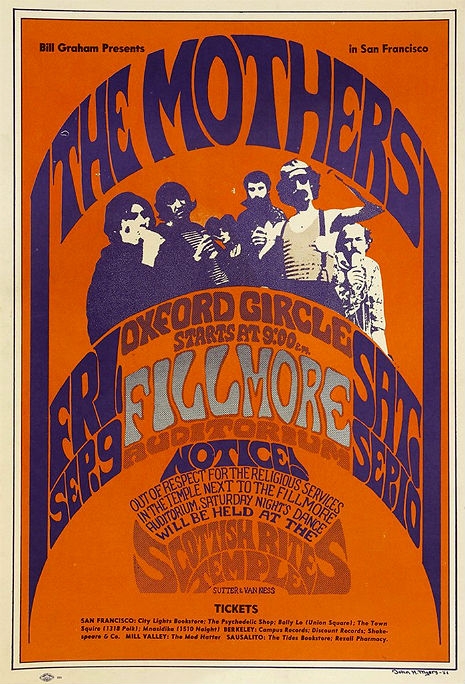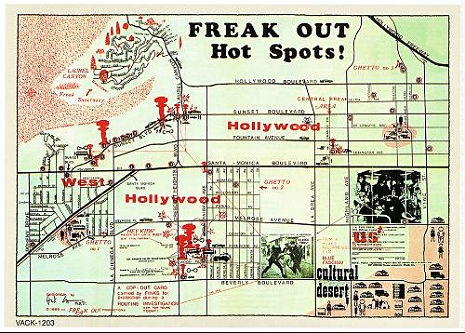
These Mothers is crazy. You can tell by their clothes. One guy wears beads and they all smell bad. We were gonna get them for a dance after the basketball game but my best pal warned me you can never tell how many will show up…sometimes the guy in the fur coat doesn’t show up and sometimes he does show up only he brings a big bunch of crazy people with him and they dance all over the place. None of the kids at my school like these Mothers…specially since my teacher told us what the words to their songs meant.
Sincerely forever, Suzy Creamcheese, Salt Lake City, Utah.
Freak Out!, the 1966 debut album by Frank Zappa and The Mothers of Invention was one of the first two-record sets of the rock era (Dylan’s Blonde On Blonde beat it by a week) and it was definitely the first two-record debut by any group. Although the album wasn’t a commercial success, making it only to #130 on the Billboard charts, it immediately established the archly intellectual Frank Zappa in the very first rank of rock musicians. In fact, Paul McCartney was said to be so impressed with Freak Out! that the album apparently provided the initial inspiration for The Beatles’ Sgt. Pepper’s album. At first there may not have been a lot of listeners, but most certainly the right people were tuning into Frank Zappa and the Mothers of Invention’s freaky vibe from the start.
Freak Out! was produced by legendary African-American record producer Tom Wilson, who also worked with Simon and Garfunkel, Sun Ra, The Velvet Underground, Eric Burdon and The Animals and Bob Dylan (Wilson produced three Dylan albums and the “Like a Rolling Stone” single). The story goes that Wilson signed The Mothers to MGM thinking that they were a white blues band. He had heard just one song. “Trouble Every Day,” when he saw them at a club on the Sunset Strip and incorrectly assumed the group was something like Al Kooper’s group, The Blues Project!

They were anything but. The Mother’s uncompromising sound was an unheard of combination of corny doo-wop (which Zappa both loved and parodied mercilessly), R&B, tape manipulations, musique concrète ala Zappa’s idol Edgard Varese, free jazz, shifting time signatures, classical music touches and trenchant satirical social observations (Zappa was nasty to both “straights” and hippies in equal measure, even his own audience had their noses tweaked by Frank Zappa, one of history’s ultimate non-conformists).
The story of the early days of the Mothers of Invention is a fascinating one, but basically, the Cliff Notes version is this: In 1965, Frank Zappa, a would-be film soundtrack composer, recording studio owner and rock guitarist living in the incredibly boring San Bernadino country city of Rancho Cucamonga, CA was invited to join a local rhythm and blues band called the Soul Giants. The band was renamed “The Mothers” (as in “motherfuckers,” indicating how good of musicians they were). The Mothers started gigging in Los Angeles and soon Frank Zappa was the “Freak king” of Hollywood. (Historical note here: LA’s “Freaks” were basically weirder hippies and they dressed differently from the way San Francisco hippies tended to dress, which in 1965-66 was far more “Edwardian” than it was tie-died. The LA vs SF, freaks vs hippies issue was a short-lived one, but a distinction that is important to note. The “Freaks” were the people (mostly Valley girls) who congregated around Carl Franzoni (“Captain Fuck”), teenage Szou and her “aging Beatnik” boyfriend (later husband) Vito Paulekas. “Vito and his Freakers” participated in sex orgies and went out to art openings and the clubs on the Sunset Strip enlivening every event they attended with their distinctive dancing. This clip, from the “mondo” film You Are What You Eat was actually shot at a Mother’s performance, but the filmmakers couldn’t get the music rights and used a song by the Electric Flag instead. It’s probably as good of a representation of Vito and his Freakers as exists).
In other words, there was a “built in” scene for Frank Zappa to take advantage of when the Mothers moved to Los Angeles. He came to town, looked around and he took it over. Quickly. By 1966, Zappa was a figure who loomed large over the Sunset Strip.

The first songs the Mothers (rechristened “The Mothers of Invention” at the insistence of MGM) recorded with Wilson were “Any Way the Wind Blows” and “Who Are the Brain Police?” In The Real Frank Zappa Book, FZ described the scene in the studio:
“I could see through the window that he was scrambling toward the phone to call his boss—probably saying: ‘Well, uh, not exactly a “white blues band,” but…sort of.’”
Wilson would champion Zappa’s creative vision to the label, securing him an unheard of recording budget for Freak Out! and putting his own career on the line for the ambitious young composer/bandleader. The album’s psychedelic cover art direction was a bit misleading, perhaps, but due to the freak “hot spots” map of Hollywood, the liner notes indicating all of Zappa’s “friends and family” and inspirations (David Crosby, Tiny Tim, Charles Mingus, Guitar Slim, Eric Dolphy, Igor Stravinsky and others are all there, now the subject of a documentary called The Freak Out List) and the fact that it was a two-record set gave his new fans something to immerse themselves in and obsess over (Zappa fans are an obsessive lot, trust me on that one). Zappa understood his audience well: Freak Out! was the rock music equivalent of getting into Marvel Comics and discovering that there was an entire Marvel “universe” to pour over. It was if Zappa and his freaky scene landed like Martians during the middle of the Lyndon Johnson administration. It was fortuitous timing, right as the world was about to go from B&W to vivid color.

Because Freak Out! was deleted from the MGM catalog in the early 1970s and was not in print again in the USA until Rykodisc released the Zappa catalog on CD in the late 1980s, it’s not really an album that tons of people have heard. It’s an album that should rightfully be held in the same high regard as the debut albums by the Velvets, Jefferson Airplane, Love or the Doors and is tragically less well-known than it should be (no, I’m not saying that Freak Out! is an obscure album, because it’s not, but how many people who are hip to something like, say, Forever Changes, have never heard even a single song from it?)
Although it can safely be assumed that the music on Freak Out! is indeed pretty freaky, it’s not at all inaccessible. The very first song I’d play for someone to introduce them to the album would be “Trouble Every Day,” the same song that intrigued Tom Wilson enough to sign the band on the spot. In it Zappa describes watching the Watts Riots on TV:
“Motherly Love,” a lascivious clarion call to groupies everywhere in which the Mothers let it be known that they are up for anything, that they’re, uh, “packing heat” and that they’re going to basically fuck all the women when they come to your town. How in the world this got on an album in 1966 is beyond me!
“Hungry Freaks Daddy,” written for Carl Franzoni (“He is freaky down to his toe nails. Some day he will live next door to you and your lawn will die” wrote Zappa in the Freak Out! liner notes). This song is the first number on the album.
Below, “Return of the Son of Monster Magnet”—this footage was shot by Ed Seeman and was intended to demonstrate the concept of “underground marketing” and show how Freak Out! could be advertised. Zappa apparently screened this film at a marketing convention in Chicago.